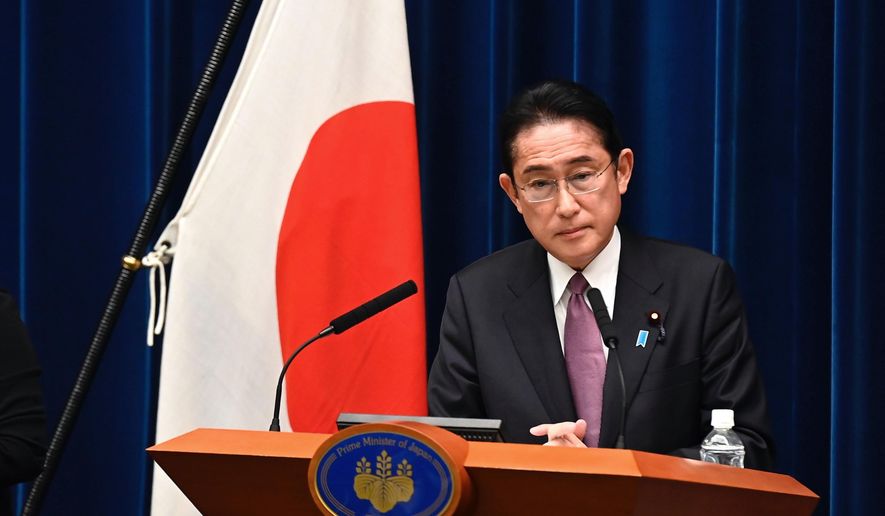SEOUL — A central focus of Japanese Prime Minister Fumio Kishida’s meeting with President Biden in Washington on Friday will be the intensifying U.S.-Japan security relationship at a moment of rising threats from North Korea and China.
This is a surprise for some Japan watchers.
While Mr. Kishida is certainly familiar with defense matters, as a resident of Hiroshima and the author of “Toward a World Without Nuclear Weapons,” he was widely seen as a dove before winning Japan’s premiership in September 2021.
Only in office has his inner warrior stepped forth. He is now leading Japan’s biggest armament program since World War II, while also expanding Tokyo’s strategic relations beyond the core U.S. alliance.
His government announced in December that it would double Japan’s military spending by 2028 — bringing the nation into line with the NATO standard of 2% of GDP.
The first major defense purchases look set to be hundreds of U.S. Tomahawk long-range cruise missiles, granting Japan a standoff strike capability against enemy bases.
SEE ALSO: New role, relevance for Tokyo as allies confront challenge from China
Meanwhile, top U.S. and Japanese officials met in Washington this week and issued a blunt statement condemning China’s increasing aggressiveness, while calling out Russia for its war in Ukraine and castigating North Korea for ramping up its nuclear and missile programs.
Secretary of State Antony Blinken, Defense Secretary Lloyd Austin and their Japanese counterparts, Yoshimasa Hayashi and Yasukazu Hamada, also added a formal mention of outer space in the U.S.-Japan security treaty, say attacks “from and within space” may trigger the treaty’s mutual defense provisions.
This is strong stuff for Mr. Kishida, a man seen by many as softer on defense than his predecessors Yoshihide Suga and the late Shinzo Abe.
Publicly, Mr. Kishida had never shared Abe’s enthusiasm for rewriting Japan’s pacifist constitution. And, before becoming premier, he was best known as Japan’s longest-serving foreign minister.
He headed the ruling Liberal Democratic Party’s dovish “Kochikai” faction, which treasured Japan’s peace constitution.
“Kochikai has a pro-China tradition, and Mr. Kishida would look to carefully balance the Sino-Japanese relationship and the Japan-U.S. alliance,” Japanese academic Daisuke Akimoto predicted in print just prior to Mr. Kishida’s election.
The prediction proved off-base, and Mr. Kishida’s pivot to defense has surprised many during the months since.
“It was not shocking but was a little different from what I expected,” said Lim Eun-jung, a Japan watcher and international relations specialist at Korea’s Kongju University. “Last year I got several chances to travel to Japan and meet defense people and my impression was that they were very sensitive about Ukraine, and they tend to connect Ukraine to the Taiwan issue.”
Prior to Mr. Kishida’s arrival in Washington, the prime minister was in Europe, where inked a defense cooperation agreement with British Prime Minister Rishi Sunak — an agreement modeled on one he had previously signed with Australia.
Mr. Kishida’s tour of European capitals meant he was unable to watch an airborne drill in Chiba Prefecture on Jan. 9. On that day, for the first time ever, Japanese and U.S. paratroopers in Japan jumped alongside Australian and British counterparts.
The Japanese prime minister seems to have been shaken by the Russian invasion of Ukraine. “Ukraine today could be East Asia tomorrow,” he warned during a security summit last year.
On China, he seems wary of Beijing’s activities around the Japanese-administered but disputed Senkaku/Diaoyu Islands; its weaponization of reefs and islets in the South China Sea; and its increasing assertiveness toward Taiwan — dangerously proximate to Japan’s Ryukyu Islands.
Mr. Kishida inherits groundwork laid by preceding administrations. The “Quad” security dialogue that unites Japan with Australia, India and the United States was championed by Abe, who originally coined the term “Indo-Pacific.”
While Mr. Kishida expands alliances beyond Japan’s customary horizons, there is no question about the strength of the U.S. alliance. America stations some 50,000 troops in Japan, which provides what has been described as an “unsinkable aircraft carrier” off continental Asia.
Amid the strategic amity, however, one conundrum exists that Mr. Biden and Mr. Kishida will likely dance around during their meeting: The U.S. shelters Japan under a nuclear umbrella that the Hiroshima-bred Mr. Kishida is emotionally opposed to.
“I think nuclear deterrence sits uncomfortably in the Japanese establishment,” said Alex Neill, a Singapore-based security consultant who notes that Japan is a “threshold nuclear power” capable of going critical if events demand.
Nonetheless, Mr. Kishida’s broader defense posture appears set to provide a bonanza for U.S. arms exporters. “The American conventional deterrence gravy train has done very, very well in the Asia-Pacific region,” said Mr. Neill.
• Andrew Salmon can be reached at asalmon@washingtontimes.com.




Please read our comment policy before commenting.